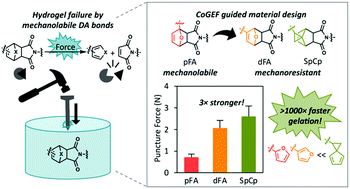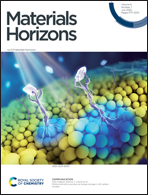Rational mechanochemical design of Diels–Alder crosslinked biocompatible hydrogels with enhanced properties†
Abstract
An important but often overlooked feature of Diels–Alder (DA) cycloadditions is the ability for DA adducts to undergo mechanically induced cycloreversion when placed under force. Herein, we demonstrate that the commonly employed DA cycloaddition between furan and maleimide to crosslink hydrogels results in slow gelation kinetics and “mechanolabile” crosslinks that relate to reduced material strength. Through rational computational design, “mechanoresistant” DA adducts were identified by constrained geometries simulate external force models and employed to enhance failure strength of crosslinked hydrogels. Additionally, utilization of a cyclopentadiene derivative, spiro[2.4]hepta-4,6-diene, provided mechanoresistant DA adducts and rapid gelation in minutes at room temperature. This study illustrates that strategic molecular-level design of DA crosslinks can provide biocompatible materials with improved processing, mechanical durability, lifetime, and utility.



 Please wait while we load your content...
Please wait while we load your content...